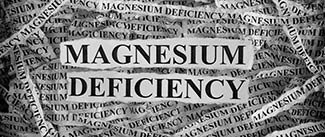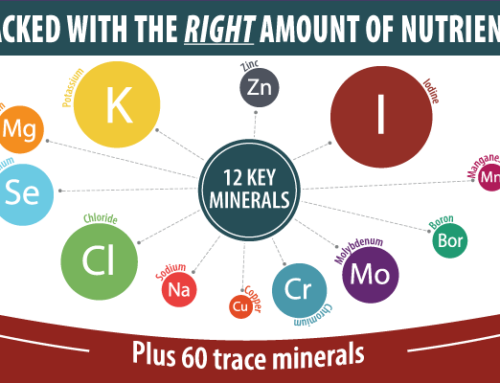It may be shocking but magnesium deficiency affects 68% of Americans! Magnesium deficiency is common since the American diet is rich in proteins, carbohydrates, and fats but it is generally poor in magnesium (Mg). Additionally, most vitamin and mineral supplements taken to ensure adequate nutrition provide magnesium in only minimal amounts, if at all. Magnesium is a mineral that is essential for health in optimal quantities, if we are to obtain full benefit from the foods we eat and from the supplements we take.
Magnesium is needed by our bodies to activate numerous enzymes that control metabolism of carbohydrates, fats and electrolytes; to assist in the utilization of other essential minerals, including calcium (Ca) and to build the nucleic acids and our body’s proteins from the amino acids provided by the proteins found in food. Without adequate Magnesium, energy production falters and proteins cannot be produced in sufficient quantities for normal growth and development of infants, children, adolescents and pregnant women. Magnesium also is important in repair of wear and tear of everyday living, in maintaining resistance to infection, in protecting against cardiovascular, kidney and bone disease, and in meeting the excess needs caused by emotional or physical stress.
By: the late Mildred S. Seelig, M.D., Master of Public Health, Master of the American College of Nutrition, Adjunct Professor of Nutrition, University of North Carolina Medical Center, Chapel Hill
Copyright© 2019 Mineral Resources International – all rights reserved – Unauthorized duplication forbidden
Preventing Magnesium Deficiency and Requirements
On a milligram per kilogram (mg/kg) of lean body weight basis, women have been shown to need 4.5-5 mg/kg/day and men to need at least 6 mg/kg/day to remain in Magnesium balance as determined by analysis of metabolic balance studies done worldwide. (1,2) These studies disclosed that, on marginal intakes, there was better retention of Magnesium by young women than by young men. The Food and Nutrition Board of the National Research Council, National Academies of Science have long estimated that the Recommended Dietary Allowances (RDAs) for Magnesium intakes (an amount estimated as enough to prevent diseases associated with Magnesium deficiency) are 300 mg/day for women and 350/day for men. (3) The RDA for Magnesium was increased to 310-320 mg/day for women and 400-420 mg/day for men in the 1997 edition, entitled Dietary Reference Intakes (DRI), (4) in which new dietary categories were developed, including Tolerable Upper Limits (UL).
The UL designates supplemental amounts estimated to result in adverse effects if habitually exceeded. The Magnesium UL was limited to avoid diarrhea in unduly vulnerable subjects. The ULs for Ca, phosphate and vitamin D, high intakes of which interfere with Magnesium utilization (see below), were increased substantially more than was the UL for Magnesium.
Are the RDAs for Magnesium Optimal?
Optimal Magnesium intakes are amounts that maintain normal functioning of the body and prevent disorders treatable with Magnesium supplements. Research, done throughout the world, shows that the original RDA for Magnesium is not even sufficient to assure compensation for the amount lost in excreta and sweat, in the presence of even minor physical or mental exertion or competition, aggravation or other stresses, all of which increase Magnesium requirements (5-8) (see below). Even for adults living non-stressful, not particularly active lives, it is not enough merely to maintain Magnesium balance, which is the term used to describe the equilibrium between Magnesium intake and output.
The amount actually consumed from self-selected diets, as shown in the United States (9-14), Europe (15-18) and Asia (19-21) is less than the RDA, and is far less than the amount shown to be required to maintain equilibrium in metabolic balance studies. (1, 2, 10, 32)
No one can afford to lose more Magnesium than is provided by the diet. When that happens, the person is in negative Magnesium balance. This means that, in order to maintain normal vital functions, the Magnesium that is already in the body that is serving to activate enzymes, to maintain energy and normal electrolyte levels in the cells, as well as to form healthy structures, is drawn upon, with the result that some tissues are broken down to meet the demands of organs needed to sustain life. The higher figures for the RDA established in 1997 might be closer to optimal amounts of Magnesium, being estimated as the amounts needed to prevent damage to the body and to maintain health. All tissues are at risk of malfunction and/or physical injury when Magnesium levels are low; they include the heart, arteries, kidneys, bones, hormones, muscles, nerves, brain, skin and the gastrointestinal organs. Chronic or long-term magnesium deficiency is contributory to development of many disorders and diseases. (8) Treatment of these illnesses can intensify the problem because many medications increase Magnesium loss.
Related article: Many Medications can Induce Electrolyte Deficiency
What happens when Magnesium Deficiency is Severe?
 When the deficiency is acute and severe, it can cause seizures or rapid, irregular heartbeats (arrhythmias) that can prove fatal. Which disorders develop will depend upon one’s hereditary predisposition. (22-24) Some families are prone to high blood pressure and other types of cardiovascular disease, some to kidney stones, some to bone thinning, chronic fatigue, muscle cramping, nervousness and some types of severe, recurrent headaches – in all of which subnormal Magnesium levels have been encountered and increased Magnesium intakes have proven helpful.
When the deficiency is acute and severe, it can cause seizures or rapid, irregular heartbeats (arrhythmias) that can prove fatal. Which disorders develop will depend upon one’s hereditary predisposition. (22-24) Some families are prone to high blood pressure and other types of cardiovascular disease, some to kidney stones, some to bone thinning, chronic fatigue, muscle cramping, nervousness and some types of severe, recurrent headaches – in all of which subnormal Magnesium levels have been encountered and increased Magnesium intakes have proven helpful.
Positive Magnesium balance is achieved when the body retains some of the Magnesium that is consumed, rather than eliminating an amount equal to the amount ingested and absorbed. The retained Magnesium participates in building healthy new tissue, a state that is called anabolism. This is the condition found in pregnant and nursing mothers, in those who have not reached full growth and maturation and in athletes who are developing their musculature. It is also the state of people recovering from illness, surgery or accidental trauma. A positive Magnesium balance indicates that this vital mineral is being used in the formation of the proteins of muscles, whether our limbs, heart, arteries, kidneys or hormones. Magnesium is also necessary to form normal bones – to convert vitamin D to one of the hormones needed for utilization of Ca, (25-27) which is the major structural component of bone. Less widely considered is the role of Magnesium in forming the organic portion of bone (bone matrix) that prevents brittleness and protects against fractures. (28)
To attain positive Magnesium balance, its daily intake must be optimal – adequate to meet special requirements. The amount needed by those undergoing growth and development, repair or participating in strenuous exercise is greater than the amount needed by adults living sedentary lives. Even the recently increased RDAs are unlikely to be optimal for individuals with such special needs. Adolescent boys and girls, especially those engaged in athletics, can require as much as 7-10 mg/kg/day. Pregnant women, particularly those with more than one fetus, those who have undergone frequent pregnancies, or who themselves have not attained full growth, have high Magnesium requirements – at least 450 mg/day. (29) Growing and developing infants and children are also in need of high daily intakes of Magnesium.
Related article: Magnesium and Mom- Risks of Low Magnesium During Pregnancy
Dietary Components
Calcium, Phosphate and Vitamin D Ratios
Magnesium intakes have fallen slightly over the twentieth century in the United States, but the Calcium/Magnesium dietary ratio, which was about 2/1 in the first quarter of the century, (30) has risen and the RDAs for Ca and vitamin D (the vitamin that increases Ca absorption) have been increased. These are nutrients that have been shown to interfere with Magnesium retention yet require Magnesium for their normal utilization. Phosphate intake has also risen as a result of its addition to processed foods and soft drinks and this also interferes with Magnesium absorption. (31) The RDAs for Ca and phosphate are given as 1000 mg/day each in the 1997 book that raised the RDA for Magnesium to a lesser degree. (4) The tolerable upper level (UL) for Ca is given as 2500 mg, for phosphate as 3500 mg and for vitamin D as 2000 units. However, the UL for Magnesium supplements is limited to 350 Magnesium, which, added to that in food and water, might increase the daily Magnesium intake to about 650 mg. For those accepting the upper limit as desirable, unphysiologic Calcium/Magnesium ratios can result. The high tolerable upper limit for Calcium, phosphate, and vitamin D can intensify Magnesium deficiency.
Carefully done human metabolic studies have verified that high Calcium/Magnesium and phosphate/magnesium dietary intakes (within the limits of usual diets and below the ULs cited by the Food and Nutrition Board) have been shown to cause negative Magnesium balance. Compilation and analysis of early extensive Magnesium balance studies of normal young adults showed that at Magnesium intakes below 5 mg/kg/day, negative balances of both Magnesium and Calcium develop when Calcium intakes are not particularly high. (1, 32) On Magnesium intakes below 300 mg/day, Magnesium balances were consistently either negative or barely in balance at Ca intakes of 1 g/day. At 5-6 mg/kg/day of Magnesium, Ca intakes below 1 g/day allowed for positive Magnesium balances and Ca intakes above 1 g/day diminished. Very high Ca intakes can result in negative Magnesium balance if Magnesium intake is low. The Ca balance is positive with high Calcium/Magnesium dietary ratios, but in such a circumstance, the Ca deposition can be in the soft tissues such as the arteries and kidneys, as well as in bone. High Magnesium intakes do not interfere with Ca retention and improve Ca retention unless Ca intake is very low. This is implemented by the favorable effect Magnesium has on the hormones that control Ca absorption and its metabolism.
Related article: Magnesium, The Forgotten Mineral
Magnesium Requirements
A Calcium/Magnesium ratio of 2/1, provided by the daily Magnesium intake of 600 mg and a Ca intake of 1200 mg/day, was considered suitable for maintenance of health in 1935 (30) on the basis of study of the literature then available. The current RDA allowances provide a Ca/Mg ratio of 3/1; the UL allows for 4/1 or higher ratios. Since phosphate excess intensifies Magnesium loss, (31) the high UL for phosphate can aggravate the problem. Until there are definitive data as to optimal intakes under different physiologic and pathologic conditions, Magnesium intakes should be increased to no less than 6 mg/kg/d for young adults. (1, 2, 16)
In a study of elderly men, whose dietary Magnesium intake was maintained at their customary 250 mg/day and their Ca intake was raised to 1400 mg/day, negative Magnesium balance developed. (33) When their Magnesium intake was increased to 500 mg, Magnesium equilibrium was restored. Similarly, a negative Magnesium balance was produced by increasing their phosphate intake from the close to the RDA level of 975 mg/day to 1500 mg daily – an amount that is common in the American diet and is less than half of the tolerable UL.
Calcium and Magnesium in Young Women
An important study of 15 young women, who underwent three consecutive 20 day balance periods, while on a diet that provided RDA levels of Magnesium (265 to 305 mg), Ca (1008 to 1085 mg), RDA levels of phosphate and which provided a Ca/Mg ratio of 3.7/1, showed that on controlled RDA intakes, they lost about 50 mg of Magnesium a day. (34) The authors considered this to be an indication that not less than 6 mg/kg/day of Magnesium is needed by young women. They also observed a gradual rise in serum cholesterol, despite low dietary fat intake during the three observation periods. That vitamin D is required for the absorption of Ca is widely recognized, an effect that has been relied upon to prevent rickets in children. High doses are now recommended, along with a high dosage of Ca, to protect against osteoporosis. Excess Vitamin D also raises blood levels of cholesterol. (35, 36)
Related article: Magnesium for Asthma and Lung Health
Fat, Sugar and Alcohol Affect Magnesium Deficiency
High levels of fat within the intestine, whether it is derived from fatty foods or intestinal dysfunction, such as steatorrhea or short bowel, directly interfere with the absorption of both Magnesium and Calcium by formation of indigestible complexes of Magnesium and/or the Calcium with the fat. (37) Excess absorbed fat can lead to high blood cholesterol. Most important are resultant high levels of low-density lipoprotein- cholesterol (LDL-C), which is called a “bad fat,” because it, and the triglycerides, cause atherosclerosis. In contrast, the high-density cholesterol (HDL-C) fraction is the “good lipid” because it reduces fat deposition in arteries. HDL-C is low in patients with cardiovascular disease, while the level of LDL-C is high.
Very important is what Magnesium does to the ratio of HDL-C to LDL- C. The observation that Magnesium supplements increase the HDL-C/LDL-C ratio in the blood of normal subjects and in patients with high blood pressure or with coronary heart disease (38-41) is an explanation of one of the benefits of increasing Magnesium uptake.
High sugar intake, high blood sugar levels common in diabetic patients and moderate alcohol consumption cause renal loss of Magnesium.(42, 43) Heavy alcohol drinking causes severe Magnesium deficiency, not only from the renal loss, but also as a result of poor diet and hormonal disturbances that develop in patients with cirrhosis of the liver, a consequence of chronic alcoholism.
Related article: Magnesium and Heart Disease – What’s the link?
Protein
Adequate protein intake is necessary for optimal Magnesium retention. This was shown in adolescent girls and boys and women on diets that had marginal supplies of Magnesium and protein. Their Magnesium balance was improved by increasing their protein intake from low to normal. Diets containing sufficient Magnesium for growth and development (10-16 mg/kg/day) in adolescent boys resulted in positive balances regardless of the protein intake. (44) However, very high protein intakes have been shown to increase the risk of Magnesium deficiency, when the diets were low or marginal in Magnesium. This was first shown in infants with protein calorie malnutrition, whose protein deficiency had been repaired without correcting their Magnesium deficit. They developed cardiac arrhythmias that could terminate fatally in those not provided Magnesium supplementation. (45) Arrhythmias, attributable to loss of Magnesium, have also been reported as a result of consuming a liquid protein diet for weight reduction, (46) an approach to obesity that resulted in what was called “liquid protein mayhem” because it resulted in deaths caused by ventricular arrhythmias. (47)
Magnesium Deficiency Increases Vulnerability to Disease; Decreases Resistance to Stress
Cardiovascular, Renal, Bone Diseases
 The diseases receiving most attention as being associated with magnesium deficiency are those of the arteries and the heart. (8, 22) Many experimental studies in laboratory animals have demonstrated that Magnesium deficiency alone, especially in combination with nutrients that interfere with Magnesium utilization, causes cardiovascular damage resembling that seen in diseases that afflict mankind. Studies of disease frequency in different parts of the United States, and throughout the world, have disclosed that poor Magnesium intake from food and/or water is more prevalent in regions where cardiovascular diseases are a greater problem than where Magnesium intake is high. (48) Hard water (containing predominantly Mg) has been found to be protective.
The diseases receiving most attention as being associated with magnesium deficiency are those of the arteries and the heart. (8, 22) Many experimental studies in laboratory animals have demonstrated that Magnesium deficiency alone, especially in combination with nutrients that interfere with Magnesium utilization, causes cardiovascular damage resembling that seen in diseases that afflict mankind. Studies of disease frequency in different parts of the United States, and throughout the world, have disclosed that poor Magnesium intake from food and/or water is more prevalent in regions where cardiovascular diseases are a greater problem than where Magnesium intake is high. (48) Hard water (containing predominantly Mg) has been found to be protective.
The southeast of the United States, where the water is soft and poor in Magnesium, is known as the “heart disease – kidney stone belt.” In contrast, the north Midwestern states, which have water supplies rich in Magnesium, have fewer cases of heart disease. Since some hard waters are rich in Ca, its possibly protective effect has also been proposed. However, studies from Finland implicate a Ca/Mg ratio of 4/1 in the very high death rate of middle-aged men from coronary heart disease in that country. (49) Because high Ca intake is currently recommended to decrease the risk of osteoporosis, it is noteworthy that the incidence of osteoporosis is very high in Finland, despite lifelong high Ca/Mg intake ratios. (48, 49) Another clue that high Ca/Mg dietary ratios and nutrients such as vitamin D, increase Ca absorption but intensify cardiovascular damage of Magnesium deficiency, is the increase in cardiovascular disease in Japan, since their diet has become more like the low Mg, high Ca American diet. (20) Their earlier low incidence of coronary heart disease was correlated with their low Ca/Mg dietary ratio. (49)
Using Magnesium to Treat Illness
Physicians have used Magnesium to treat patients since the first third of the twentieth century, regarding it as a medication, rather than a nutrient, that might protect against manifestations of diseases that respond favorably to its administration. Its use to manage the seizures and high blood pressure of women with toxemia of pregnancy was begun by 1925, (50) a use predicated on the early demonstration that experimental Magnesium deficiency induced convulsions, hypertension and arterial lesions in animals. Magnesium treatment has been used to control the arrhythmias caused by digitalis treatment of congestive heart failure, an effect that was first reported in Germany in 1935 (51) and in the United States in 1943. (52) It is accepted treatment in conditions in which arrhythmias are a risk ((in congestive heart failure (53-55)), after cardiac surgery (56,57) and even in forms of arrhythmia resistant to drug therapy. (58)
Loss of Magnesium caused by diuretic drugs used to control edema or hypertension also causes side effects which are manageable by Magnesium repletion. Poorly controlled diabetic patients are another group long known to have Magnesium deficiency (59) for whom Magnesium administration has been helpful.
Read related article: Significant Risks of Low Magnesium During Pregnancy, By Dr. Mildred Seelig
Syndrome X, Insulin Resistance, Cardiovascular Metabolic Disease
Determination of intracellular Magnesium and Calcium levels has provided important insights into the interrelationships of several diseases usually considered quite separate. It has been discovered that resistance to the effects of insulin, previously thought to be a problem only in diabetes, is also found in patients with other metabolic disturbances involving abnormal Mg and Ca levels in their tissues.(60-66) Among these disorders are hypertension (with and without heart disease or diabetes), obesity (with and without diabetes), pregnancy complicated by high blood pressure and abnormal processes associated with aging. The existence of insulin resistance in these different conditions has led to the use of encompassing terms such as: syndrome X, insulin resistance syndrome and generalized cardiovascular-metabolic disease. Common to them all are subnormal intracellular Mg/Ca ratios. It is thus provocative that Magnesium deficiency has been directly correlated with development of insulin resistance (67) and that Magnesium supplements have restored responsiveness to insulin. The observation that healthy people, who reach and surpass 100 years of age, have higher total body Magnesium and lower Calcium levels than the usual elderly person, (66) suggests an intriguing possibility: might increased Magnesium allay some of the deleterious processes of aging?
Stress and Neuromuscular Disorders
Stress increases the secretion of adrenalin and corticosteroid hormones can lead to Magnesium deficiency. These stress hormones mobilize Magnesium from the cells and increase its renal excretion. It is paradoxical that Magnesium inadequacy increases secretion of stress hormones (5-7) – a vicious cycle. Might this be why Type A individuals are more prone to heart attacks than are those of a more tranquil disposition? The types of stresses that can increase Magnesium requirements can be physical (i.e. exhausting or competitive exercise, exposure to extremes of temperature, accidental or surgical trauma) or psychological (i.e. anger, fear, anxiety, depression, grief, tension). In continental Europe, individuals who complain of such psychological manifestations are often diagnosed as having latent tetany, associated with marginal Magnesium deficiency. (68-70) These patients frequently suffer from pronounced fatigue, leg cramps and recurrent headaches, including migraine, as well as psychological problems. In the United States, where Magnesium levels are not often determined in seeking an explanation of the complaints that often lead to psychiatric consultation, a comparable disorder is usually diagnosed as chronic fatigue syndrome. (70)
Why is Magnesium Deficiency Often Missed?
Most of the body’s Magnesium is within the cells, rather than in the blood plasma or serum, and it is from analysis of serum or plasma levels of minerals that a diagnosis of Magnesium deficiency is usually made. (71)
The kidneys can limit the loss of Magnesium to very small amounts if plasma levels drop. However, there can be Magnesium deficiency in the tissues even when plasma levels are normal. When plasma Magnesium is below what is accepted as the low limit of normal, that is a clear indication of deficiency. Adequacy, however, is not assured by plasma levels that remain within a normal range of values. On request, more information can be provided on the methods of determining Magnesium
levels.
The signs of Magnesium deficiency universally recognized are convulsions and cardiac arrhythmias, but these are signs of severe deficiency. The early arterial lesions (of the linings of the arteries and their muscles) are free of signs, as are early lesions of the heart and kidneys. The neuromuscular signs of nervousness, irritability, anxiety, gastrointestinal symptoms are more often considered manifestations justifying psychiatric care or investigation of intestinal status rather than closer attention paid to the diet. Osteoporosis, accepted as a largely nutritional problem, is treated by increasing mineralization (Ca and vitamin D intakes) without attention to the fact that in Finland, where Ca intake is high and Mg intake is low, both osteoporosis and cardiovascular disease are serious problems. (48)
Adaptation to Long-Term Low Magnesium Intakes
The difficulty in diagnosing Magnesium deficiency stems from the unreliability of plasma values and the fact that there are few overt signs of early Magnesium deficiency – which affect internal tissues that have symptom-free damage. Furthermore, the body has the ability to maintain equilibrium, even when levels of essential nutrients (like Magnesium) in the body are subnormal. (32, 72) The available evidence indicates that it takes varying but usually prolonged periods of time for the body to adjust to changed Magnesium intakes by retaining amounts needed for optimal functioning.
Related article: A Fascinating Look at Vitality and Health
Conclusions
When the first analysis of Magnesium intakes and balances in normal young adults (32) was published in 1964, (1) Magnesium deficiency was suggested as a neglected factor in vulnerability to heart disease. It was then suggested that an explanation of the lesser risk of young women might be their maintenance of Magnesium equilibrium on lower intakes. The lower rates of cardiovascular diseases in men in the East than the West was deemed attributable in part to higher mg/kg/day Magnesium intakes in the Orient (from diets comprised largely of soy products, vegetables and fish) than in occidental countries. More cardiovascular disease, however, has become a problem in countries such as Japan and in some areas in China, where the diet has changed. (20, 76-80)
A high sodium intake is unquestionably a factor in high blood pressure, but low Magnesium intake is contributory. In Japan, emphasis is placed on the need, not only to lower salt, but to increase the Magnesium content of the diet in order to protect against cardiovascular disease. (20, 76-78, 80) Large- scale American surveys and reviews of data implicate low dietary intake and serum levels of Magnesium in cardiovascular disease in the United States. (48, 73-75) Fewer studies have correlated low Magnesium intake with osteoporosis but the coexistence of both heart and bone disease in conditions associated with Magnesium loss, including diabetes (81) and alcoholism, (82) is provocative. (48) This recalls the prevalence of both heart disease and osteoporosis in Finland where Mg intake is low. (48) Also, the elderly who eat diets rich in vegetables, which are diets high in
Mg, have greater bone density and thus are less prone to osteoporosis, than are those with less Mg-rich diets, (83) just as they are less prone to cardiovascular disease.
Copyright© 2019 Mineral Resources International Unauthorized duplication forbidden
About the Author
The late Mildred S. Seelig, M.D., MPH, was a world-renowned researcher who studied the role of Magnesium in health and disease for more than forty years. The author of numerous peer-reviewed articles and an international lecturer, she was also a master of the American College of Nutrition and a founding editor of the college’s professional journal.
1. Seelig MS: The requirement of magnesium by the normal adult. Am J Clin Nutr 14:342-390, 1964
2. Seelig MS: Magnesium requirements in human nutrition. Magnes Bul 3(1a):26-47, 1981.
3. National Research Council. Recommended Dietary Allowances (RDAs) Ed 9, National Academy Press, Washington D.C. 1980
4. Institute of Medicine. Dietary Reference Intakes for Calcium, Phosphorus, Magnesium, Vitamin D and Fluoride. National Academy Press, Washington D.C. 1997
5. Seelig MS: Consequences of magnesium deficiency enhancement of stress reactions; preventive and therapeutic implications. J Am Coll Nutr 13:429446, 1994.
6. Classen HG, Porta S, Schinler R: Coping with acute stress reaction by plentiful oral magnesium supply. Magnes Bul 17:1-8, 1995.
7. Cernak I, Savic V, Kotur J, Prokic V, Kuljic B, Grbovic D, Veljovic M: Alterations in magnesium and oxidative status during chronic emotional stress. Magnes Res 13:29-36, 2000.
8. Seelig MS: Magnesium in the Pathogenesis of Disease: Early Roots of Cardiovascular, Skeletal and Renal Abnormalities. Publ: Plenem Press, NY 1980.
9. Pao EM, Mickle SJ: Problem Nutrients in the United States. Food Technol 35:58-69, 1981.
10. Lakshamanan FL, Rao RB, Kim WW, Kelsay JL: Magnesium intakes, balances, and blood levels of adults consuming self-selected diets. Am J Clin Nutr 40:1380-1389, 1984.
11. Morgan KJ, Stampley GL, Zabik ME, Fischer DR: Magnesium and calcium dietary intakes of the U.S. population. J Am Coll Nutr 4:195-206, 1985.
12. Lichton IJ: Dietary intake levels and requirements of Mg and Ca for different segments of the U.S. population. Magnesium 8:117-123, 1989.
13. Pennington JA, Young BE, Wilson DB: Nutritional elements in U.S. diets: results from the Total Diet Study, 1982 to 1986. J Am Diet Assoc 89: 659- 64m 1993.
14. Hallfrisch J, Muller DC: Does diet provide adequate amounts of calcium, iron, magnesium, and zinc in a well-educated adult population? Exp Gerontol 28:473-483, 1993.
15. Abdulla M, Behbehani, A, Dashti H: Marginal deficiency of magnesium and the suggested treatment. In (Y. Itokawa, J. Durlach E’s) Magnesium in Health and Disease, J. Libbey, London, 1989 (4th Intl Mg Sympos, Kyoto, 1988), pp 111-117.
16. Durlach J: Recommended dietary amounts of magnesium: Mg RDA. Magnes Res 2:195-203, 1989.
17. Glei M, Anke M: Magnesium content of foodstuffs and beverages and magnesium intake of adults in Germany. Magnes Bul 17:22-28, 1995.
18. Cashman KD, Flynn A: Optimal nutrition: Calcium, magnesium and phosphorus. Proc Nutr Soc 58:477-487, 1999.
19. Goto S: Magnesium intake and its balance in Japanese. Magnes Bul 9:51, 1987.
20. Kimura M, Nagai K, Itokawa Y: Food habits and magnesium intake of Japanese. In (Y. Itokawa, J. Durlach e’s) Magnesium in Health and Disease, J. Libbey, London, 1989 (5th Intl Mg Sypmos, Kyoto, 1988), pp 63-69.
21. Singh RB: Effect of dietary magnesium supplementation in the prevention of coronary heart disease and sudden cardiac death. Magnes Trace Elem 9:143-151, 1990.
22. Seelig MS: Nutritional status and requirements of magnesium, with consideration of individual differences and prevention of cardiovascular disease. Magnesium Bul 8:170-185, 1986.
23. Henrotte JG: The importance of genetic and constitutional factors in Human red blood cell magnesium control. In (M. Cantin, M.S. Seelig, eds) Magnesium in Health and Disease Spectrum, New York, 1980 – (2nd Intl Mg Sympos Quebec, 1976) pp 921-927.
24. Henrotte JG: Recent advances on genetic factors regulating blood and tissue magnesium concentrations; relationship with stress and immunity. In (Y. Itokawa, J. Durlach eds) Magnesium in Health and Disease, J. Libbey, London, 1989 (5th Intl Mg Sympos, Kyoto, 1988), pp. 285-389.
25. Rude RK, Adams JS, Ryzen E, Endres DB, Hiimi H, Horst RL, Haddad JG Jr, Singer FR: Low serum concentrations of 1,25-dihydroxyvitamin D in human magnesium deficiency. J Clin Endocrinol Metab 61:833-940, 1985.
26. Fuss M, Bergmann P, Bergans A, Bagon J, Cogan E, Pepersack T, VanGossum M, Corvilain J: correction of low circulating levels of 1,25- dihydroxyvitamin D by 25-hydroxy vitamin D during reversal of hypomagnesaemia. Clin Endocrinol Oxf 31:31-38, 1989.
27. Fatemi S, Ryzen E, Flores J, Endres DB, Rude RK: Effect of experimental human magnesium depletion on parathyroid hormone secretion and 1,25-dihydroxyvitamin D metabolism. J Clin Endocrinol Metab 73:1067-1072, 1991.
28. Seelig MS: Increased magnesium need with use of combined estrogen and Calcium for osteoporosis. Magnesium Res 3:197-215, 1990
29. Franz KB: Magnesium intake during pregnancy. Magnesium 6:18- 27, 1987.
30. Schmidt CLA, Greenberg DM: Occurrence, transport, and regulation of calcium, magnesium, and phosphorus in the animal organism. Physiol Rev 15:297-434, 1935.
31. Franz KB: Influence of phosphorus on intestinal absorption of calcium and magnesium. In Magnesium in Health and Disease, Proc 5th Intl Mg Sympos, Eds Y Itokawa & J. Durlach, Publ John Libbey & Co. pp 71-78, 1989.
32. Hathaway ML: Magnesium in human nutrition. Home Economics Report #19, Agric Res Serv, USDA, Washington DC, 1962.
33. Spencer H, Lesniak M, Kramer L, Coffey J, Osis D: Studies of magnesium metabolism in man. In M Cantin & MS Seelig, Eds Magnesium in Health 6 © 2009 Mineral Resources International, Inc. All Rights Reserved. 6 and Disease, Publ Spectrum, NY:pp 912-919.
34. Irwin MI, Feeley R: Frequency and size of meals and serum lipids, nitrogen and mineral retention, fat digestibility and urinary thiamine and riboflavin in young women. Am J Clin Nutr 20:816-824, 1967.
35. Seelig MS: Vitamin D and cardiovascular, renal and brain damage in infancy and childhood. Ann NY Acad Sci 147, 539-582, 1969.
36. Linden V: Correlations of vitamin D intake to ischemic heart disease, hypercholesterolemia and renal calcinosis. In “Nutritional Imbalance in Infant and Adult Disease,” Ed MS Seelig, Publ Spectrum, NY, NY, 1977, pp 23-42.
37. Booth CC, Babouris MB, Hanna S, MacIntyre I: Incidence of Hypomagnesaemia in intestinal malabsorption. Brit Med J 2:141-43, 1963.
38. Rasmussen HS, Aurup P, Goldstein K, McNair P, Mortensen PB, Larsen OG, Lawaetz H: Influence of magnesium substitution therapy on blood lipid composition in patients with ischemic heart disease. A double-blind, placebo controlled study. Arch Inern Med 140:1050-1053, 1989.
39. Singh RB, Rastogi SS, Mani UV, Seth J, Devi L: Does dietary magnesium modulate blood lipids? Biol Trace Elem Res 30:50-64, 1991.
40. Corica F, Allegra A, Di Benedetto A Giacobbe MS, Romano G, Cucinotta C, Buemi M, Ceruso D: Effects of oral magnesium supplementation on plasma lipid concentrations in patients with noninsulin- dependent diabetes mellitus. Magnesium Res 7:43-46, 1994.
41. Kisters K, Hausberg M, Tokmak F, Koneke J, Westermann G, Rahn KH: Hypomagnesaemia, borderline hypertension and hyperlipidaemia. Magnesium-Bul 21:31-34, 1999.
42. Linderman RD: Influence of various nutrients and hormones on urinary divalent cation excretion. Ann NY Acad Sci 162:802-809, 1969.
43. Lemann J Jr, Lennon EJ, Piering WR, Prien EL Jr, Ricanati ES: Evidence that glucose ingestion inhibits net renal tubular reabsorption of calcium and magnesium in man. J Lab Clin Med 75:578- 585,1970.
44. Schwartz R, Walker G, Linz MD, MacKellar I: Metabolic responses of adolescent boys to two levels of dietary magnesium and protein. I. Magnesium and nitrogen retention. Am J Clin Nutr 26:510-518, 1973.
45. Caddell JL: The effect of magnesium therapy on cardiovascular and electrocardiograph changes in severe protein-calorie malnutrition. Trop Geogr Med 21:33-38, 1969.
46. Michiel RR, Sneider JS, Dickshein RA, Hayman H, Eich RH: Sudden death in a patient on a liquid protein diet. New Eng J Med 298:1005-1007, 1978.
47. Wadden TA, Stunkard AJ, Brownell KD, Van Itallie TB: The Cambridge diet. More Mayhem?JAMA 250:2833-2844, 1983.
48. Seelig MS: Epidemiologic data on magnesium deficiency-associated cardiovascular disease and osteoporosis; consideration of risks of current recommendations for high calcium intake. In Advances in Magnesium Research: Nutrition and Health. (In Press) Proc of 9th International Symposium on Magnesium,Vichy, France.
49. Karppannen H, Pennanen R, Passinen L: Minerals, coronary heart disease and sudden coronary death. Adv Cardiol 25:9-24, 1978.
50. Lazard EM: A preliminary report on the intravenous use of magnesium sulphate in puerperal eclampsia. Am J Obst Gynec 9:178-188, 1925.
51. Zwillilnger L: [effect of magnesium on the heart.] (LA: German; Engl Transl Available) Klin Wschr 14:1429-1433, 1935.
52. Boyd LJ, Scherf D: Magnesium sulfate in paroxysmal tachycardia. Am J Med Sci 206:43 48,1943.
53. Dyckner T, Wester PO: Magnesium deficiency in congestive heart failure. Acta Pharmacol Toxicol Copenh 54 suppl 1:119-123, 1984.
54. Eichhorn EJ, Tandon PK, DiBianco R, Timmis GC, Fenster PE, Shannon J, Packer M: Clinical and prognostic significance of serum magnesium concentration in patients with severe chronic congestive heart failure: The PROMISE Study. J Am Coll Cardiol 21:634-640,1993.
55. Ceremuzynski L, Gebalska J, Wolk R, Makowska E: Hypomagnesaemia in heart failure with ventricular arrhythmias. Beneficial effects of magnesium supplementation. J Intern Med 247:78-86, 2000.
56. England MR, Gordon G, Salem M, Chernow: Magnesium administration and dysrhythmias after cardiac surgery. JAMA 268:2395-2402, 1992.
57. Caspi J, Rudis E, Bar I, Safadi T, Saute M: Effects of magnesium on myocardial function after coronary artery bypass grafting. Ann Thorac Surg 59:942- 947, 1995.
58. Tzivoni D, Keren A, Cohen AM, Loebel H, Zahavi I, Chenzbraun A, Stern S: Magnesium therapy for torsades de pointes. Am J Cardiol 53:528-530, 1984.
59. Martin HE, Wertman M: Serum potassium, magnesium and calcium levels in diabetic acidosis. J Clin Invest 26:217-228, 1947.
60. Resnick LM: Cellular ions in hypertension, insulin resistance, obesity, and diabetes: a unifying theme. J Am Soc Nephrol 3 (4 Suppl):S78-85, 1992.
61. Resnick LM: Ionic basis of hypertension, insulin resistance, vascular disease, and related disorders. The mechanism of “syndrome X.”Am J Hypertens 6:123S-134S, 1993.
62. Resnick L: The cellular ionic basis of hypertension and allied clinical conditions. Prog Cardiovasc Dis 42 1-22, 1999.
63. Paolisso G, Galzerano D, Gambardella A, Gentile S, Lama D, Varricchio M: Low fasting and insulinmediated intracellular magnesium accumulation in hypertensive patients with left ventricular hypertrophy: role of insulin resistance. Hypertens 9:199-203, 1995.
64. Barbagallo M, August PA, Resnick LM: Altered cellular calcium responsiveness to insulin in normal and hypertensive pregnancy. J Hypertens 14:1081- 1085, 1996.
65. Paolisso G, Sgambato S, Pizza G, Passariello N, Varricchio M, D’Onofiro F: Improved insulin response and action by chronic magnesium administration in aged NIDDM subjects. Diabetes Care 12:256-269, 1989.
66. Paolisso G, Taglamonte MR, Rizzo MR, Rotondi M, Gualdiero P, Gambardella A Barbieri M, Carella C, Giugliano D, Varricchio M: Mean arterial blood pressure and serum levels of the molar ratio of insulin-like growth factor-1 to is binding protein-3 in centenarians. J Hypertens 17:67-73, 1999.
67. Nadler JL, Buchanan T, Natarajan R, Antonipillai I, Gergman R, Rude R: Magnesium deficiency produces insulin resistance and increased thromboxane synthesis. Hypertension 21 (6 Pt 2): 1024-1029, 1993.
68. Durlach J: Chronic magnesium deficit, tetany and neurovegetative dystonia. Magnes-Bul 3(1a): 121-136, 1981.
69. Durlach V: Bara M, Guiet-Bara A: Neurotic, neuromuscular and autonomic nervous form of magnesium imbalance. Magnes Res 10:169-195, 1997.
70. Seelig MS: Review and hypothesis: might patients with chronic fatigue syndrome have latent tetany of magnesium deficiency. J Chron Fatigue Syndr 4:77-108, 1998.
71. Elin RJ: Magnesium metabolism in health and disease. Dis-a-month 34-161-218, 1988.
72. Hunscher HA: Pertinent factors in interpreting metabolic data. J Am Dietet Assoc 39:201-219, 1961.
73. Ma J, Folsom AR, Melnick SL, Eckfeldt JH, Sharrett AR, Nabulsi AA, Hutchinson RG, Metcalf PA: Associations of serum and dietary magnesium with cardiovascular disease, hypertension, diabetes, insulin, and carotid arterial wall thickness: the ARIC study. Atherosclerosis Risk in Communities Study. J Clin Epidemiol 48:927-940, 1995.
74. Marx A, Neutra RR: Magnesium in drinking water and ischemic heart disease. Epidemiol Rev 19:258-272, 1997.
75. Liao F, Folsom AR, Brancati FL: Is low magnesium concentration a risk factor for coronary heart disease? The Atherosclerosis Risk in Communities (ARIC) Study. Am Heart J 136:480-490, 1998.
76. Sei M, Nakamura H, Miyoshi T: Nutritional epidemiological study on mineral intake and mortality from cardiovascular disease. Tokushima J Exp Med 40:199-207,1993.
77. Itoh K, Kawasaki I, Uezono K: [Relationship of dietary intake of sodium, potassium, calcium and magnesium to blood pressure] Nippon Koshu Eisei Zasshi 42:95-103, 1995.
78. Mizushima S, Tsuchida K, Yamori Y: Preventive nutritional factors in epidemiology: interaction between sodium and calcium. Clin Exp Pharmacol Physiol 2:573-575, 1999.
79. Gao M, Ikeda K, Hattori H, Miura A, NaraY, Yamori Y: Cardiovascular risk factors emerging in Chinese populations undergoing urbanization. Hypertens Res 22:209-215, 1999.
80. Liu L, Mizushima S, Ikeda K, Hattori H, Miura A, Gao M, Nara Y, Yamori Y: Comparative studies of dietrelated factors and blood pressure among Chinese and Japanese: Results from the China-Japan Cooperative Research of the WHO-CARDIAC Study. Cardiovascular Disease and Alimentary Comparison. Hypertens Res 23:413-420, 2000.
81. Saggese G, Berelloni S, Baroncelli GI, et al: Bone demineralization and impaired mineral metabolism in insulin-dependent diabetes mellitus. A possible role of magnesium deficiency. Helv Paediatr Acta 43:405-414, 1989.
82. Abbot L, Nadler J, Rude RK: Magnesium deficiency in alcoholism: possible contribution to osteoporosis and cardiovascular disease in alcoholics. Alcohol Clin Exp Res 19:1076-1082, 1994.
83. Tucker KL, Hannan MT, Chen H, Cupples LA, Wilson PW, Kiel DP: Potassium, magnesium, and fruit and vegetable intakes are associated with greater bone mineral density in elderly men and women. Am J Clin Nutr 69:727-736, 1999.






